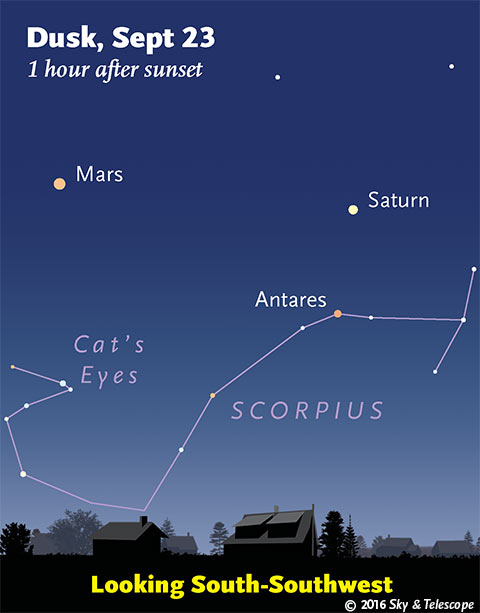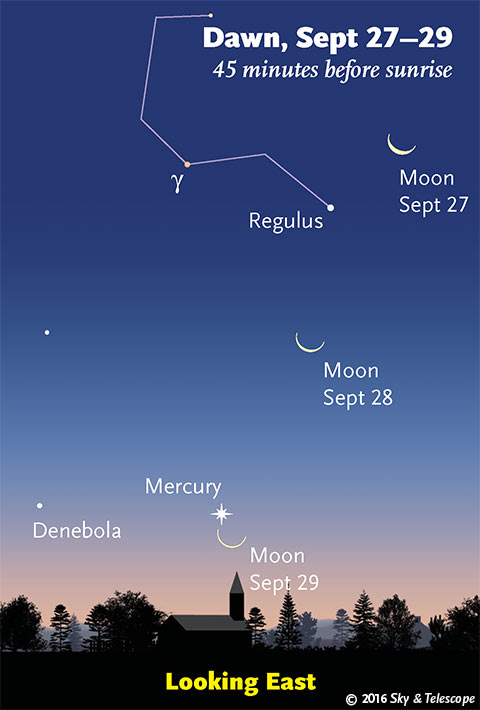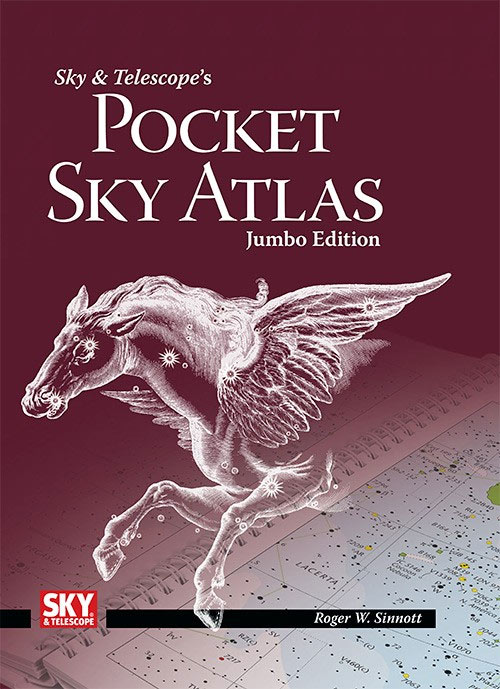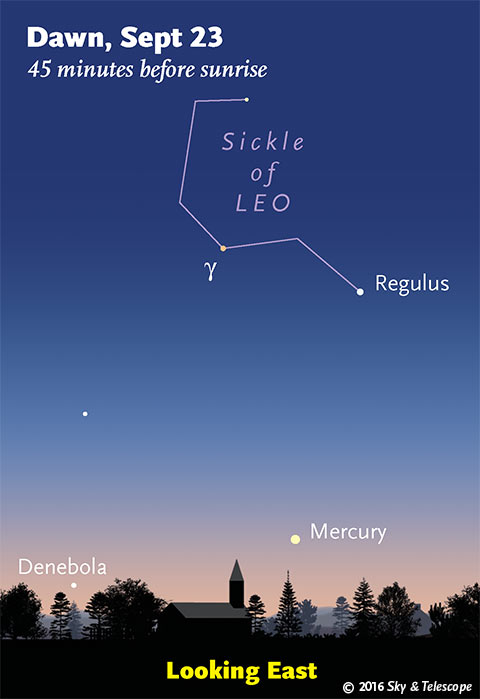Astronomy - This Week’s Sky at a Glance, September 23 – October 1

In the southwest at dusk, Saturn and Antares continue to pull farther away to the right of Mars. Summer ended yesterday, so this is a good time to declare that the triangle they make, the nightly celestial emblem of Summer 2016, is breaking up and losing its identity.
Friday, September 23
• The starry W of Cassiopeia stands high in the northeast after dark. The right-hand side of the W (the brightest side) is tilted up.
Look along the second segment of the W counting down from the top. Notice the dim naked-eye stars along that segment (not counting its two ends). The one on the right is Eta Cassiopeiae, magnitude 3.4, a Sun-like star just 19 light-years away with an orange-dwarf companion — a lovely binary in a telescope.
The "one" on the left, fainter, is a wide naked-eye pair: Upsilon1 and Upsilon2 Cassiopeiae, 0.3° apart. They're orange giants unrelated to each other, 200 and 400 light-years from us.
• Last-quarter Moon (exact at 5:56 a.m. Eastern Daylight Time on this date). The Moon rises around midnight or 1 a.m. on the morning of Saturday the 24th. Once it's fairly well up you'll see that it's in Gemini, with Castor and Pollux to its left. Orion is much farther to its right.
• Algol is at its minimum light, magnitude 3.4 instead of its usual 2.1, for about two hours centered on 11:19 p.m. EDT.Info and comparison-star chart.
Saturday, September 24
• This is the time of year when the rich Cygnus Milky Way crosses the zenith in the hour after nightfall is complete (for skywatchers at mid-northern latitudes). The Milky Way rises straight up from the southwest horizon, passed overhead, and runs straight down to the northeast.
Sunday, September 25
• About a half hour after your local sunset time, look for Venus very low in the west-southwest through the twilight. It's on its way to a grand apparition as the "Evening Star" high in the southwest this winter.
Monday, September 26
• Arcturus shines in the west these evenings as twilight fades out. Equally-bright Capella (they're both magnitude 0) is barely rising in the north-northeast, depending on your latitude; the farther north you are, the higher it will be. Late in the evening, Arcturus and Capella shine at the same height in their respective compass directions. When will this happen? It depends on both your latitude and longitude.

As dawn brightens in the east, the crescent Moon wanes and steps lower past Regulus and Mercury on successive mornings.
• Early Tuesday morning the 27th, the waning crescent Moon is about 6° upper right of Regulus (for North America), as shown at right. Look 17° below or lower right of Regulus for Mercury.
Tuesday, September 27
• This is the time of year when, during the evening, the dim Little Dipper "dumps water" into the bowl of the Big Dipper way down below. The Big Dipper will dump it back in the evenings of spring.
• As dawn brightens Wednesday morning the 28th, spot the thin crescent Moon between Regulus above it and Mercury below it, as shown at right.
Wednesday, September 28
• As dawn brightens Thursday morning the 29th, look for a super-thin crescent Moon near Mercury very low in the east. Start looking about 45 minutes before your local sunrise time. Binoculars will help as dawn grows bright.
Thursday, September 29
• The Two Top Miras. Chi Cygni now overhead in the evening, and Mira (Omicron Ceti) visible late at night, are the two brightest Mira-type stars in the sky: long-period red variables. Chi Cyg should be at or just past its maximum brightness, 5th magnitude or so. Mira should be nearly at its minimum, 8th or 9th mag. Follow them through the coming months with the article and finder charts in the October Sky & Telescope, page 49. As one brightens and the other dims, when will they pass each other in brightness?
Friday, September 30
• This is the time of year when the Little Dipper extends left from Polaris after dark. The Little Dipper's only two bright stars are Polaris, the end of the Dipper's handle, and Kochab, the lip of its bowl. Both are 2nd magnitude. They're exactly level with each other about a half hour after dark now, depending on your latitude.
• New Moon (exact at 8:11 p.m. Eastern Daylight Time).
Saturday, October 1
• As Deneb takes over from Vega as the star at the zenith after dark (for mid-northern latitudes), dim Capricornus takes over from Sagittarius as the zodiacal constellation standing due south. It is ever thus.
_________________________
Want to become a better astronomer? Learn your way around the constellations! They're the key to locating everything fainter and deeper to hunt with binoculars or a telescope.
This is an outdoor nature hobby. For an easy-to-use constellation guide covering the whole evening sky, use the big monthly map in the center of each issue of Sky & Telescope, the essential guide to astronomy.

The Pocket Sky Atlas plots 30,796 stars to magnitude 7.6 — which may sound like a lot, but it's less than one per square degree on the sky. Also plotted are many hundreds of telescopic galaxies, star clusters, and nebulae. Shown above is the new Jumbo Edition for easier reading in the night. Click image for larger view.
Once you get a telescope, to put it to good use you'll need a detailed, large-scale sky atlas (set of charts). The basic standard is the Pocket Sky Atlas (in either the original or new Jumbo Edition), which shows stars to magnitude 7.6.
Next up is the larger and deeper Sky Atlas 2000.0, plotting stars to magnitude 8.5, nearly three times as many. The next up, once you know your way around, is the even larger Uranometria 2000.0 (stars to magnitude 9.75). And read how to use sky charts with a telescope.
You'll also want a good deep-sky guidebook, such as Sue French's Deep-Sky Wonders collection (which includes its own charts), Sky Atlas 2000.0 Companion by Strong and Sinnott, or the bigger Night Sky Observer's Guide by Kepple and Sanner.
Can a computerized telescope replace charts? Not for beginners, I don't think, and not on mounts and tripods that are less than top-quality mechanically (meaning heavy and expensive). And as Terence Dickinson and Alan Dyer say in their Backyard Astronomer's Guide, "A full appreciation of the universe cannot come without developing the skills to find things in the sky and understanding how the sky works. This knowledge comes only by spending time under the stars with star maps in hand."
This Week's Planet Roundup

Mercury emerging at dawn. It's growing brighter daily.
Mercury has jumped up to shine low as dawn brightens. Look due east about 45 minutes before your local sunrise time. Mercury triples in brightness from magnitude +0.4 on the morning of September 24th to – 0.8 a week later (October 1st). Don't confuse it with Regulus 15° or 20° above it.
Venus (magnitude –3.9) is low in the west-southwest in twilight. Look for it there starting about 25 or 30 minutes after sunset.
Mars (magnitude 0.0) shines in the south-southwest at dusk. It's passing above the Sagittarius Teapot.
Jupiter is out of sight in conjunction behind the Sun.
Saturn (magnitude +0.5) shines far to the lower right of Mars at dusk, in the southwest. Look for Antares (twinkling at magnitude +1.0) 6° below and perhaps a bit left of Saturn, as shown at the top of this page.
Uranus (magnitude 5.7, in Pisces) and Neptune(magnitude 7.8, in Aquarius) are fairly well up after nightfall is complete, in the east and southeast, respectively. Info and finder charts.
__________________________
All descriptions that relate to your horizon — including the words up, down, right, and left — are written for the world's mid-northern latitudes. Descriptions that also depend on longitude (mainly Moon positions) are for North America.
Eastern Daylight Time (EDT) is Universal Time (UT, UTC, or GMT) minus 4 hours.
__________________________
"This adventure is made possible by generations of searchers strictly adhering to a simple set of rules. Test ideas by experiments and observations. Build on those ideas that pass the test. Reject the ones that fail. Follow the evidence wherever it leads, and question everything. Accept these terms, and the cosmos is yours."
— Neil deGrasse Tyson
— Neil deGrasse Tyson
No comments:
Post a Comment